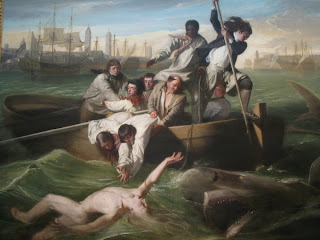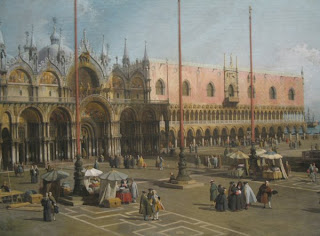Wednesday, June 18, 2008
Saturday, June 14, 2008
Visiting with Old Friends
One of my favorite museums in Washington D.C. is the National Gallery of Art. While other people flock to the International Spy Museum, the new Newseum, and the Holocaust Museum (all of which cost more than $15), I cherish the renewal of my mind, spirit, and soul as I absorb the masterful works of art on display—and pay only the $1.35 metro fee that lands me a few blocks away. (Correction: the Holocaust Museum is no charge.) This past weekend, with the weather hovering at a “Comfort” Level of over one hundred degrees (Comfort? Who are they kidding?), the museum offers the added bonus of a temperature and humidity-controlled environment.
This is the third time I’ve visited the National Gallery of Art in the last 3 years. When I go, it’s like visiting familiar friends. With each visit I renew my friendship and understanding, say “Ah, yes, this is why you appeal to me.” The playful French, the passionate Italian and Spanish, the precision of the German and the life-like images of the Dutch—I love them all. Here’s a smattering of some favorites. I took all of these photos two years ago with a point-and-shoot, hand-held digital camera using natural light. It’s tough to get sharp images, but you’re not allowed to use a tripod or a flash.

In a nod to the recent shark attach at our beach, I was pulled instantly to this sensational oil (John Copley Singleton, Watson and the Shark, 1778). The painting is based on a true event, the 1749 attack on 14-year-old Brook Watson while swimming in Havana Harbor.

Spanish artist Bartolomé Esteban Murillo painted Two Women at a Window (c. 1655/1660). It is unclear whether or not the scene depicts a young woman with a laughing chaperone in innocent play or a young courtesan attempting to lure a customer. I love the expression on the young woman's face.

The incredible still life by Flemish painter Osias Beert the Elder (Dishes with Oysters, Fruit, and Wine, c. 1620/1625) is a rich and gorgeous depiction of 17th century food. I love the detail.

Orazio Gentileschi's The Lute Player (c. 1612/1620) is more about the woman than the lute. The detail of her dress, how it’s constructed, and the rich folds of the heavy cloth and the warmth it exudes are pleasing.

The Square of Saint Mark’s, Venice (1742/1744) is by Italian painter Canaletto. I love the grandness of the square, the open sky, and the people going about their lives.

Finally, I must choose at least one Impressionist painting. This one, Girl Arranging Her Hair (1886) is by Mary Cassatt, an American. I love the colorful, playful, and vibrant tones of impressionist painting.
This is the third time I’ve visited the National Gallery of Art in the last 3 years. When I go, it’s like visiting familiar friends. With each visit I renew my friendship and understanding, say “Ah, yes, this is why you appeal to me.” The playful French, the passionate Italian and Spanish, the precision of the German and the life-like images of the Dutch—I love them all. Here’s a smattering of some favorites. I took all of these photos two years ago with a point-and-shoot, hand-held digital camera using natural light. It’s tough to get sharp images, but you’re not allowed to use a tripod or a flash.

In a nod to the recent shark attach at our beach, I was pulled instantly to this sensational oil (John Copley Singleton, Watson and the Shark, 1778). The painting is based on a true event, the 1749 attack on 14-year-old Brook Watson while swimming in Havana Harbor.

Spanish artist Bartolomé Esteban Murillo painted Two Women at a Window (c. 1655/1660). It is unclear whether or not the scene depicts a young woman with a laughing chaperone in innocent play or a young courtesan attempting to lure a customer. I love the expression on the young woman's face.

The incredible still life by Flemish painter Osias Beert the Elder (Dishes with Oysters, Fruit, and Wine, c. 1620/1625) is a rich and gorgeous depiction of 17th century food. I love the detail.

Orazio Gentileschi's The Lute Player (c. 1612/1620) is more about the woman than the lute. The detail of her dress, how it’s constructed, and the rich folds of the heavy cloth and the warmth it exudes are pleasing.

The Square of Saint Mark’s, Venice (1742/1744) is by Italian painter Canaletto. I love the grandness of the square, the open sky, and the people going about their lives.

Finally, I must choose at least one Impressionist painting. This one, Girl Arranging Her Hair (1886) is by Mary Cassatt, an American. I love the colorful, playful, and vibrant tones of impressionist painting.
Labels:
Art,
Travel,
Washington D.C.
Wednesday, June 04, 2008
Two Stories Made Me Smile
“They say” that you shouldn’t read the front page of the newspaper because it causes stress. And normally I would whole-heartedly concur. Today’s freebie news rag that greeted me at my bed & breakfast table space was The Free Lance-Star (Fredericksburg, Virginia).
The story that caught my eye, “Stafford school lets kids start becoming bilingual early on,” reported that a popular elementary school Spanish program will continue next year. Hooray for the good guys! As a linguistics major, I am a huge fan of early bilingual education. For a whole bunch of reasons. One, it is well-known that early second language learners are more successful at actually learning the new language. It’s just plain easier to acquire a second (or third or … ) language when you’re young (I’m talking under 10 here). Two, people who learn more than just their mother tongue learn more about the world, languages in general, and more about their own language.
(If you’ve ever studied German or Russian, you appreciate English’s non-existent noun declension system. If you don’t know what I’m talking about, well, there you go. But in German, for example, when you say
I think learning a second language is one of the most mind-expanding experiences (along with learning to play a musical instrument). For those of you who say “it’s too difficult”, a 5 year old child knows the grammar of her native language (the child might get a few exceptions wrong, but mostly she has internalized all the rules). Children learn by hearing in context. They abstract. They generalize. And then they learn the exceptions.
Okay, enough linguistics. The second story that made me smile was “It’s Official: Obama Has Won”.
The story that caught my eye, “Stafford school lets kids start becoming bilingual early on,” reported that a popular elementary school Spanish program will continue next year. Hooray for the good guys! As a linguistics major, I am a huge fan of early bilingual education. For a whole bunch of reasons. One, it is well-known that early second language learners are more successful at actually learning the new language. It’s just plain easier to acquire a second (or third or … ) language when you’re young (I’m talking under 10 here). Two, people who learn more than just their mother tongue learn more about the world, languages in general, and more about their own language.
(If you’ve ever studied German or Russian, you appreciate English’s non-existent noun declension system. If you don’t know what I’m talking about, well, there you go. But in German, for example, when you say
I give you the books.the word “book/books” changes according to how it’s used in the above sentences. The noun (book/books) inflects based on its number (plural or singular) and case (nominative, accusative, dative, or genitive). Russian has all this plus two additional cases: prepositional and instrumental. In English, the noun inflects on number only.)
I am carrying the books.
I didn’t read the book.
This is my book.
I hit you with the books.
The books are red.
I think learning a second language is one of the most mind-expanding experiences (along with learning to play a musical instrument). For those of you who say “it’s too difficult”, a 5 year old child knows the grammar of her native language (the child might get a few exceptions wrong, but mostly she has internalized all the rules). Children learn by hearing in context. They abstract. They generalize. And then they learn the exceptions.
Okay, enough linguistics. The second story that made me smile was “It’s Official: Obama Has Won”.
Labels:
Language,
Linguistics,
Ponder Points
Subscribe to:
Posts (Atom)